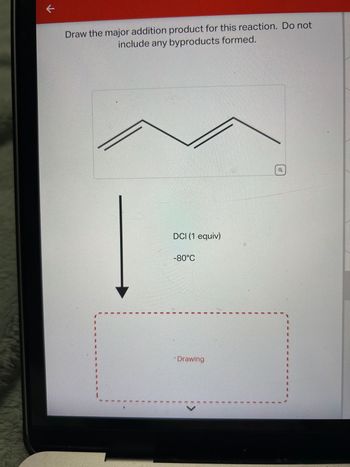
Organic Chemistry
9th Edition
ISBN: 9781305080485
Author: John E. McMurry
Publisher: Cengage Learning
expand_more
expand_more
format_list_bulleted
Concept explainers
Question

Transcribed Image Text:K
Draw the major addition product for this reaction. Do not
include any byproducts formed.
1
I
DCI (1 equiv)
-80°C
1
I
E
I
Drawing
Expert Solution
This question has been solved!
Explore an expertly crafted, step-by-step solution for a thorough understanding of key concepts.
Step by stepSolved in 3 steps with 1 images

Knowledge Booster
Learn more about
Need a deep-dive on the concept behind this application? Look no further. Learn more about this topic, chemistry and related others by exploring similar questions and additional content below.Similar questions
- OH H OH H OH H H OHN HH JE OH HI H OH F CH₂OH Consider the structure of the dissaccharide cellobiose, which is produced in the enzymatic hydrolysis of cellulose. Identify the structural components of cellobiose. MCH₂OH 水 H K H Identify every acetal carbon. A B 0 D E L Identify every hemiacetal carbon. A B H H K K M Marrow_forwardDraw the structure of the products formed in the following reactions. a) CN H,0, H* CH3 он b) H3C- -CI + CH3 c) CH3 KMNO4, A, H,O" CH3 d) Br Mg, éther CO, H*arrow_forwardName of product for each reactionarrow_forward
- Give IUPAC names for the following structures. When appropriate, abbreviate ortho (o), meta (m), and para (p), no italics, if you elect to use these terms. CH₂CH₂CHCHCHSCHCH₂ I T CH₁ CH₂ 1st structure: CH3 CH3 I 2nd structure: Submit Submit Answer Try Another Version OCH3 CH₂CCH₂ OCH3 10 item attempts remainingarrow_forwardComplete the reactions given belowarrow_forwardThioglycolic acid, HSCH2CO2H, a substance used in depilatory agents (hair removers) has pKa = 3.42. What is the percent dissociation of thioglycolic acid in a buffer solution at pH = 3.0?arrow_forward
- 15-41 Compound A(C5Hh, is not optically active and cannot be separated into enantiomers. It reacts with bromine in carbon tetrachloride to discharge the purple color of bromine and form Compound B( C.FL Br,). When Compound A is treated with H., in the presence of a transition metal catalyst, it is converted to compound C(C5H10). When treated with HC1, compound A is converted to compound DtC.HyCl). Given this information, propose structural formulas for compounds A B, C, and D. Hint: There are at least three possibilities for Compound A and, in turn, three possibilities for Compounds B. C, and D.arrow_forwardDraw the products of the two step reaction sequence shown below. Ignore inorganic byproducts. If the reaction results in a mixture of ortho and para isomers, draw only the para-product. I I I I I I Br2 (1 equiv) FeBr3 Select to Draw Problem 48 of 19 Please select a drawing or reagent from the question area Submitarrow_forward3arrow_forward
arrow_back_ios
SEE MORE QUESTIONS
arrow_forward_ios
Recommended textbooks for you

 Introduction to General, Organic and BiochemistryChemistryISBN:9781285869759Author:Frederick A. Bettelheim, William H. Brown, Mary K. Campbell, Shawn O. Farrell, Omar TorresPublisher:Cengage Learning
Introduction to General, Organic and BiochemistryChemistryISBN:9781285869759Author:Frederick A. Bettelheim, William H. Brown, Mary K. Campbell, Shawn O. Farrell, Omar TorresPublisher:Cengage Learning


Introduction to General, Organic and Biochemistry
Chemistry
ISBN:9781285869759
Author:Frederick A. Bettelheim, William H. Brown, Mary K. Campbell, Shawn O. Farrell, Omar Torres
Publisher:Cengage Learning